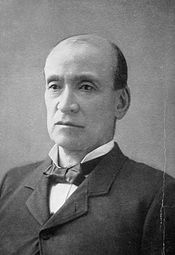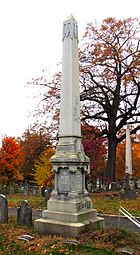- Oliver Perry Temple
-
Oliver Perry Temple 
Born Oliver Perry Temple
January 27, 1820
Greene County, Tennessee, USADied November 2, 1907 (aged 87)
Knoxville, Tennessee, USAResting place Old Gray Cemetery[1]
Knoxville, TennesseeAlma mater Washington College[2] Occupation Attorney Notable works The Covenanter, the Cavalier, and the Puritan (1897)
East Tennessee and the Civil War (1899)
Notable Men of Tennessee (1912)Political party Whig
Constitutional Union
RepublicanReligion Presbyterian[2] Spouse Scotia Caledonia Hume[2] Children Mary Boyce Temple[2] Parents James and Mary Craig Temple[2] Oliver Perry Temple (January 27, 1820 – November 2, 1907) was an American attorney, author, judge, and economic promoter active primarily in East Tennessee in the latter half of the 19th century.[2] During the months leading up to the Civil War, Temple played a pivotal role in organizing East Tennessee's Unionists. In June 1861, he drafted the final resolutions of the East Tennessee Union Convention, and spent much of the first half of the war providing legal defense for Unionists who had been charged with treason by Confederate authorities.[3] After the war, he promoted agricultural and industrial development in East Tennessee, most notably by assisting in the development of the Rugby Colony,[4] and in later years wrote several books on the history of East Tennessee.[5]
Contents
Biography
Early life
Temple was born near Greeneville, Tennessee, to farmer James Temple and wife, Mary Craig Temple. He attended Tusculum College from 1838 to 1841,[6] and attended Washington College from 1841 to 1844. After graduating from Washington College, he studied law under Knoxville judge Robert McKinney, and was admitted to the bar in 1846. In 1847, he ran for Congress on the Whig ticket, but lost to Andrew Johnson.[2]
In 1850, Temple was appointed by President Millard Fillmore commissioner to help conciliate Indian tribes in territories captured during the Mexican-American War to the United States government.[2] After returning to Knoxville, he formed a law partnership with William H. Sneed,[2] and began promoting railroad construction. He helped establish the Knoxville and Ohio Railroad in 1854, and briefly served as a director of the East Tennessee and Georgia Railroad.[2] In 1858, he built a large mansion, Melrose, named after Melrose, Scotland, the home of his wife's parents, on what is now the campus of the University of Tennessee.[2] Temple served as an elector on the Constitutional Union Party ticket during the presidential election of 1860.[3]
Secession crisis
As secession fervor swept into Knoxville in the wake of the election of Abraham Lincoln in November 1860, Temple organized a meeting for the city's Unionists at his house to plot a course of action.[3] They agreed to counter the secessionists at a November 26 citywide assembly at the Knox County Courthouse called to discuss a possible statewide secession convention. This assembly and a subsequent assembly on December 8, at which Temple delivered two speeches, were both particularly contentious, and provided a rallying point for the region's Unionists.[3] Inspired by these efforts, counties across East Tennessee held similar meetings and declared their loyalty to the Union.[3]
Temple and other Unionists canvassed East Tennessee throughout the first half of 1861. At a speech in front of a hostile crowd near what is now Concord, Temple argued that while the Constitution protected slavery, he would prefer slavery "perish" if it meant preserving the Union.[3] Temple's Gay Street office provided a popular meeting place for the city's Unionists during this period. Temple later recalled defusing a confrontation at his office between former Constitutional Union Party candidate John Bell, who had recently switched sides and supported secession, and radical Unionist newspaper editor William G. Brownlow, in May 1861.[3]
At the East Tennessee Union Convention's Greeneville session in June 1861, Temple drafted a set of resolutions that would eventually be approved by the convention and presented to the state legislature.[3] Temple's resolutions, which he drew up as an alternative to a set of resolutions earlier that day that were deemed too provocative, essentially asked the legislature to allow the counties of East Tennessee to withdraw from Tennessee and form a separate, Union-aligned state.[3] The legislature rejected the convention's requests, and Confederate forces occupied Knoxville shortly thereafter.
Civil War
Temple fled to the North in August 1861 after Brownlow warned that Confederate authorities were planning to arrest Knoxville's Unionists.[7] Within a few weeks, he returned, however, after promising the city's Confederate leaders he would remain neutral during the conflict.[7] He spent much of the first half of the war providing legal defense for Unionists accused of conspiring to burn bridges and other acts of treason.[3]
When the Union Army entered Knoxville in September 1863, Temple joyously ran the length of Gay Street behind a regiment of soldiers.[3] Shortly after the army's arrival, General Ulysses S. Grant met with Temple at Melrose, and inquired about the feasibility of marching up the French Broad River into North Carolina, and then north to Virginia in an attempt to outflank Robert E. Lee. Temple advised against this, warning that the terrain of the Blue Ridge Mountains made such a trek nearly impossible.[8]
Later life
 Temple family obelisk at Old Gray Cemetery
Temple family obelisk at Old Gray Cemetery
After the war, Temple quickly formed a new law firm with Samuel A. Rogers and James Deaderick. He served as chancellor of Tennessee's Eighth Chancery District from 1866 until 1870, and chancellor of the Second District from 1870 until 1878.[2] In 1870, Temple's annual income of more than $13,000 was the highest in Knox County, edging out the partners of the wholesaling giant, Cowan, McClung and Company.[9]
Throughout the 1870s, Temple, as the "spirit" behind the Knoxville Industrial Association and as the president of the East Tennessee Farmers' Convention, championed economic development in East Tennessee. Temple believed in a diversified economy that was based on both agriculture and industry, and gave numerous lectures extolling East Tennessee's climate and natural resources. In the late 1870s and early 1880s, Temple provided legal, agricultural, and promotional assistance to the Rugby Colony, then being developed on the Cumberland Plateau.[4] On September 16, 1880, Temple hosted a large dinner in Knoxville for the colony's founder, Thomas Hughes, and spoke at the "opening" of the colony several days later.[4]
Temple retired from the legal profession in 1880,[6] and with the help of Congressman Leonidas C. Houk, was appointed Knox County's postmaster the following year.[10] In 1897, Temple published The Covenanter, The Cavalier, and The Puritan, which discusses the origins and contributions of the Scotch-Irish (Temple uses the broader term "Covenanter") in American history. Two years later, he published East Tennessee and the Civil War, which detailed the roots and development of Unionism in East Tennessee, and recounted numerous key events which he had personally witnessed.
Legacy
Temple was a trustee of the University of Tennessee for over a half-century, from 1854 until his death in 1907, and helped establish the school's College of Agriculture.[3][4] Hess Hall, on the university's campus, now stands where his Melrose mansion once stood.[2][1] Mary Boyce Temple (1856–1929), his only child, compiled and published Notable Men of Tennessee, a collection of biographies her father had written about various Civil War-era figures. She was also a founding member of Knoxville's Ossoli Circle, and campaigned for women's suffrage in the early 20th century.[2]
Bibliography
Books
- The Covenanter, The Cavalier, and The Puritan (1897)
- East Tennessee and the Civil War (1899)
- Notable Men of Tennessee (1912)
Speeches
- "An Address Delivered Before the Knoxville Industrial Association" (1869)
See also
- Thomas William Humes
- James C. Luttrell
- Samuel Cole Williams
References
- ^ a b The Historic Mary Boyce Temple House. Retrieved: 31 October 2010.
- ^ a b c d e f g h i j k l m n East Tennessee Historical Society, Mary Rothrock (ed.), The French Broad-Holston Country: A History of Knox County, Tennessee (Knoxville, Tenn.: East Tennessee Historical Society, 1972), pp. 495-497.
- ^ a b c d e f g h i j k l Oliver P. Temple, East Tennessee and the Civil War (Johnson City, Tenn.: Overmountain Press, 1995), pp. 156-157, 172-173, 194-197, 234-235, 340, 349, 400, 474.
- ^ a b c d Fred Bailey, "Legalities, Agriculture, and Immigration: The Role of Oliver Perry Temple in the Rugby Experiment," East Tennessee Historical Society Publications, Vol. 44 (1972), pp. 90-103.
- ^ Kathleen Zebley, Oliver Perry Temple. Tennessee Encyclopedia of History and Culture, 2009. Retrieved: 10 August 2011.
- ^ a b John Wooldridge, George Mellen, William Rule (ed.), Standard History of Knoxville, Tennessee (Chicago: Lewis Publishing Company, 1900; reprinted by Kessinger Books, 2010), p. 500.
- ^ a b Robert McKenzie, Lincolnites and Rebels: A Divided Town in the American Civil War (New York: Oxford University Press, 2006), pp. 77, 98, 135, 189, 193.
- ^ Digby Gordon Seymour, Divided Loyalties: Fort Sanders and the Civil War in East Tennessee (Knoxville, Tenn.: University of Tennessee Press, 1963), p. 221.
- ^ East Tennessee Historical Society, Lucile Deaderick (ed.), Heart of the Valley: A History of Knoxville, Tennessee (Knoxville, Tenn.: East Tennessee Historical Society, 1976), pp. 34, 377.
- ^ Gordon B. McKinney, "The Rise of the Houk Machine in East Tennessee," East Tennessee Historical Society Publications, Vol. 45 (1973), pp. 61-78.
External links
- Finding Aid for the O. P. Temple Papers — University of Tennessee Special Collections
Categories:- People from Greene County, Tennessee
- People from Knoxville, Tennessee
- Tennessee Whigs
- Tennessee Republicans
- Businesspeople from Tennessee
- 19th-century American railroad executives
- 1820 births
- 1907 deaths
- Tennessee Constitutional Unionists
Wikimedia Foundation. 2010.
